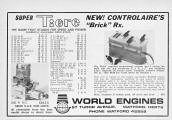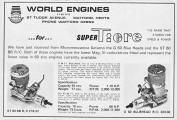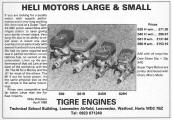Super Tigre Engines
Mr. Jaures Garofali, designer and manufacturer of the renowned “Supertigre” engies was born in Bologna, Italy in 1920.
In 1937-38 he joined Valerio Ciampolini and a Mr. Betuzzi, and the trio founded the company O.S.A.M. (Officina Sperimentale Apparecchi Motori,
or Aircraft and Engines Experimental Workshop).
The very first Garofali designed engine was the OSAM “G-1,” a 3.5 cc ignition engine. Only four or five of these little engines were built. Mr. Garofali used a progressive numbering system to designate the order for his early engines.
During 1949, Mr. Garofali parted company with Mr. Boreani who retained the OSAM name. This company had a short life and produced only a pair of different engines, the OSAM 1700 “Lilliput,” a glow engine of 1.7 cc and a 2.5 cc glow and diesel, the OSAM 2500.
The first engine produced under the Supertigre name was the G-19, an excellent 4.82 cc diesel, soon to be followed by an even more powerful glow version. In 1950, Mr. Garofali designed and produced the engine that was to become one of the most famous and most used Supertigre engines. This engine was flown by modelers in every country and produced more than its share of first places for the net fifteen years. It was the 2.5 cc Supertigre G-20 Glow.
The very first versions of this engine had a sandcast crankcase with a square exhause stack, single ball bearing on the shaft, finless head and two ring piston. The MKII was pressure die cast, dual ball bearings on the shaft, modified fuel transfer and was supplied with three different colors of plastic venturi inserts offering different choke diameters for three different kinds of models: FF, U/C Stunt and Speed.
1968
ST G60F - Engine review. Good powerful engine for the time however ST engines of the period were not renown for decent idle control as their carb lacked development; reason for this 'lateness' was that ST's focus was primarily on non-RC engines. Cross-flow scavenged but as you will see in the review the engine internals are much smoother compared to their original model showing that the need for 'gas flowing' of an engine was beginning to be considered.
1970
ST60F - General overview and comments on the improving of the design and internal layout.
1972
ST G60 RC - Engine test - Mar 1972
Known as the 'Blue head' engine and looking the same as the previous model but now fitted with the Mag-III carb which finally gave good idle performance. Cross-flow scavenged with revision to porting giving 1 Bhp @ 13500 Rpm with silencer fitted (5% nitro). Slightly heavier and not quite as powerful as some but considered good value for money.
1973
ST G21-46 - Engine test - Aug 1973
Largest model in the G21 range (not sure what G21 denotes though) and fitted with the latest Mag-III carb. Cross-flow scavenging with good quality polished internal components giving 0.72 Bhp @ 13000 Rpm silenced (5% nitro).
1974
1977
ST G60F1 - Engine test - Mar 1977 - ABC with PDP.
Revised model of 'Blue head' engine and this time utilising a carb with a larger bore in order to bring the power up to par with contemporaries. ABC construction with Cross-flow scavenging and PDP (Perry Directional Porting) has increased the engine output by 45% when comparing un-silenced figures however; the model now comes with an effective (read restrictive) silencer that results in a 20% power reduction to 1.35 Bhp @15000 Rpm (5% nitro) with silencer fitted.
1978
1988
S61-H - Engine review.







